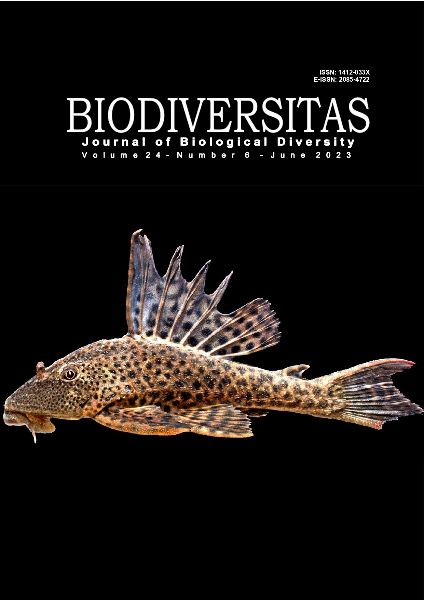The tongue morphology of Pteropus vampyrus from Timor Island, Indonesia: New insights from scanning electron and light microscopic studies
##plugins.themes.bootstrap3.article.main##
Abstract
Abstract. Selan YN, Wihadmadyatami H, Haryanto A, Kusindarta DL. 2023. The tongue morphology of Pteropus vampyrus from Timor Island, Indonesia: New insights from scanning electron and light microscopic studies. Biodiversitas 24: 3512-3518. The large flying fox (Pteropus vampyrus Linnaeus, 1758) is a Southeast Asian megabat species includes with frugivorous bats. The tongue plays a pivotal role in taking, chewing, and swallowing food. The structure of the bat tongue hampers considerable variation, mainly in the papilla. Variations occur owing to the feeding habits, environment, and adaptation of bats to their environments. The aim of this study was to clarify the morphological structure of the tongue of P. vampyrus obtained from the island of Timor, East Nusa Tenggara, Indonesia, by using Scanning Electron Microscope (SEM) and Light Microscopy(LM). This study included six adult bats regardless of sex. Macroscopically, the tongue of P. vampyrus consists of three parts: the apex, corpus, and radix. SEM and LM confirmed that the apex presents filiform papillae of several subtypes, including scale-like filiform, giant trifid, and small crown-like papillae. In addition, the apex features fungiform and transitional papillae between the giant trifid and small crown-like papillae. Furthermore, the corpus consists of filiform papillae (leaf-like filiform and large crown-like papillae) and fungiform papillae. The radix consists of filiform papillae (long conical, leaf-like filiform, and short conical papillae), fungiform papillae, and three V-shaped circumvallate papillae pointing to the larynx.
##plugins.themes.bootstrap3.article.details##
Most read articles by the same author(s)
- YUDITH VIOLETTA PAMULANG, ARIS HARYANTO, Short Communication: Molecular bird sexing on kutilang (Pycnonotus sp.) based on amplification of CHD-Z and CHD-W genes by using polymerase chain reaction method , Biodiversitas Journal of Biological Diversity: Vol. 22 No. 1 (2021)
- MARTHA PURNAMI WULANJATI, LUCIA DHIANTIKA WITASARI, NASTITI WIJAYANTI, ARIS HARYANTO, Recombinant fusion protein expression of Indonesian isolate Newcastle disease virus in Escherichia coli BL21(DE3) , Biodiversitas Journal of Biological Diversity: Vol. 22 No. 6 (2021)
- ALVITA INDRASWARI, I WAYAN SUARDANA, ARIS HARYANTO, DYAH AYU WIDIASIH, Molecular analysis of pathogenic Escherichia coli isolated from cow meat in Yogyakarta, Indonesia using 16S rRNA gene , Biodiversitas Journal of Biological Diversity: Vol. 22 No. 10 (2021)
- YUSTINUS OSWIN PRIMAJUNI WUHAN, ARIS HARYANTO, IDA TJAHAJATI, Short Communication: Molecular characterization and blood hematology profile of dogs infected by Ehrlichia canis in Yogyakarta, Indonesia , Biodiversitas Journal of Biological Diversity: Vol. 21 No. 7 (2020)
- MARTINA MARINA, GOLDA RANI SARAGIH, ULAYATUL KUSTIATI, TEGUH BUDIPITOJO, HERY WIJAYANTO, TRI WAHYU PANGESTININGSIH, ARIANA, WORO DANUR WENDO, VISTA BUDIARIATI, DWI LILIEK KUSINDARTA, Structure of reticulated python (Malayopython reticulatus) tongue using scanning electron microscopy and light microscopy , Biodiversitas Journal of Biological Diversity: Vol. 25 No. 5 (2024)
- EMILIA IKA MEGAWATI, STANISLAUS IVAN DAVIN PRADIPTA, ULFAH DAMIA, ULAYATUL KUSTIATI, HEVI WIHADMADYATAMI, DWI LILIEK KUSINDARTA, Morphological identification of the squirrel (Callosciurus notatus) tongue through Scanning Electron Microscopy (SEM) and histochemistry , Biodiversitas Journal of Biological Diversity: Vol. 24 No. 4 (2023)

